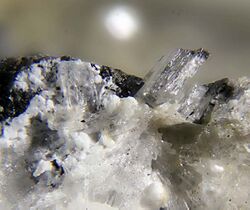Chemistry:Brassite
From HandWiki
| Brassite | |
|---|---|
 Brassite (white) accompanied by rösslerite | |
| General | |
| Category | Arsenate mineral |
| Formula (repeating unit) | Mg(AsO3OH)·4(H2O) |
| Strunz classification | 8.CE.15 |
| Dana classification | 39.01.07.01 |
| Crystal system | Orthorhombic |
| Crystal class | Dipyramidal (mmm) H-M symbol: (2/m 2/m 2/m) |
| Space group | Pbca |
| Unit cell | a = 7.472 Å, b = 10.891 Å, c = 16.585 Å; Z = 8 |
| Identification | |
| Color | White |
| Crystal habit | Cryptocrystalline crusts |
| Cleavage | {001} Perfect |
| Fracture | Irregular/uneven, splintery |
| Tenacity | Brittle |
| |re|er}} | Silky, dull, earthy |
| Streak | White |
| Diaphaneity | Translucent |
| Specific gravity | 2.28 |
| Optical properties | Biaxial (+) |
| Refractive index | nα = 1.531 nβ = 1.546 nγ = 1.562 |
| Birefringence | 0.031 |
| Pleochroism | Non-pleochroic |
| 2V angle | 80° |
| Dispersion | r < v moderate |
| Solubility | +++ HCl, + H2O |
| References | [1][2][3][4] |
Brassite is a rare arsenate mineral with the chemical formula Mg(AsO3OH)·4(H2O). It was named brassite, in 1973, to honor French chemist R`ejane Brasse, who first synthesized the compound. The type locality for brassite is Jáchymov of the Czech Republic.[2]
It occurs as an alteration of magnesium carbonate minerals by arsenic bearing solutions. It occurs associated with pharmacolite, picropharmacolite, weilite, haidingerite, rauenthalite, native arsenic, realgar and dolomite.[3]
Localities
Czech Republic:
- Jáchymov, Ore Mountains, Karlovy Vary Region, Czech Republic
France:
- Salsigne mine, Salsigne, Mas-Cabardès, Carcassonne, Aude, Languedoc-Roussillon, France
- Villanière (slag locality), Salsigne, Mas-Cabardès, Carcassonne, Aude, Languedoc-Roussillon, France
Germany:
- Wilhelm Mine (Wechselschacht), Bauhaus, Richelsdorf District, Hesse, Germany
- Ore dumps, Richelsdorf Smelter, Süss, Richelsdorf District, Hesse, Germany
References
- ↑ Webmineral.com - Brassite
- ↑ 2.0 2.1 Mindat.org - Brassite
- ↑ 3.0 3.1 "Handbook of Mineralogy - Brassite". http://www.handbookofmineralogy.com/pdfs/brassite.pdf.
- ↑ Mineralatlas.com - Brassite
- ↑ Warr, L.N. (2021). "IMA–CNMNC approved mineral symbols". Mineralogical Magazine 85 (3): 291–320. doi:10.1180/mgm.2021.43. Bibcode: 2021MinM...85..291W.
 |

